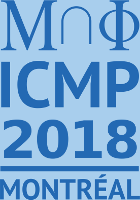Quantum Field Theory
- Karl-Henning Rehren (Univ. Göttingen)
- Hubert Saleur (IPhT CEA Saclay)
- Tuesday, Jul 24 [international i & ii]
- 16:30 David Ridout (The University of Melbourne), An introduction to logarithmic conformal field theory
- 17:00 Benjamin Doyon (King's College London), Fields associated to conical singularities in integrable QFT
- 17:30 Jörg Teschner (DESY, Theory Group), On the origin of certain dualities in two-dimensional quantum field theories
- 18:00 Feng Xu (University of California, Riverside), Rigorous results on relative entropies in CFT
- Wednesday, Jul 25 [international i & ii]
- 15:15 Joseph Varilly (Universidad de Costa Rica), String-localized Quantization: Retrospect and Prospect
- 15:45 Katarzyna Rejzner (University of York), Perturbative algebraic quantum field theory: Where we are
- David Ridout
The University of MelbourneAn introduction to logarithmic conformal field theoryIt is well known that conformal field theory (CFT) provides excellent models for the continuum scaling limits of many critical lattice theories and string dynamics pulled back to the worldsheet. The fact that many CFTs are exactly solvable owes much to the power of representation theory. Broadly speaking, there are two types of representation theories:
1. Those in which all representations are completely reducible.
2. All the rest.
In CFT, complete reducibility (together with a finiteness property) means that the theory is "rational". Otherwise, and this is by far the most common case, the theory is "logarithmic". In this talk, I will review some of the basic concepts of logarithmic CFT, focusing on the "non-rational" features and how we (are trying to) deal with them.
- Benjamin Doyon
King's College LondonFields associated to conical singularities in integrable QFTConical curvature singularities are geometric objects which can be associated to quantum fields. These have recently been identified with a new type of twist field, by extending the twist concept, usually associated with internal symmetries, to rotation transformations. I will describe the properties of these fields in two-dimensional integrable QFT and in CFT, including their OPEs and their form factor expansion. They have applications in the context of Wilson loops in supersymmetric Yang-Mills theory. They are related to - but different from - twist fields associated to branch points used to describe Riemann surfaces and calculate entanglement entropy. - Jörg Teschner
DESY, Theory GroupOn the origin of certain dualities in two-dimensional quantum field theoriesThe term duality refers in the context of quantum field theory to the existence of multiple Lagrangian or Hamiltonian representations for one and the same abstract quantum field theory, defining perturbative expansions in different regimes of the parameter space. As duality usually is a non-perturbative phenomenon, it is typically hard to demonstrate that it is realised in a given quantum field theory, and to understand why this is the case. Motivated by this, we revisit the origin of the self-duality of the Liouville quantum field theory in the light of the proof of the formula for the three-point function of Liouville theory recently given by Kupiainen, Rhodes and Vargas. The goals of my talk will be (i) to draw a coherent picture of the self-duality of Liouville theory that combines the new results of Kupiainen, Rhodes and Vargas with published and unpublished earlier work on Liouville theory, and (ii) to explain why similar phenomena should be expected to occur in much wider classes of two-dimensional quantum field theories including the sigma models relevant for the AdS-CFT correspondence. - Feng Xu
University of California, RiversideRigorous results on relative entropies in CFTInspired by Edward Witten's questions, we discuss the mutual information associated with free fermions, and we deduce many results about entropies for chiral CFT's which are embedded into free fermions, and their extensions. Such relative entropies in CFT are here computed explicitly for the first time in a mathematical rigorous way, and our results agree with previous computations by physicists based on heuristic arguments; in addition we uncover a surprising connection with the theory of subfactors, in particular by showing that a certain duality, which is argued to be true on physical grounds, is in fact violated if the global dimension of the conformal net is greater than $1.$ Based on joint work with R. Longo arxiv. 171207283. - Joseph Varilly
Universidad de Costa RicaString-localized Quantization: Retrospect and ProspectThe theory of string-localized quantum fields has emerged in recent years as an alternative to the BRST approach to QFT. One parametrizes quantum fields by spacetime variables and an extra spacelike or lightlike ray: the "string". For observables, gauge invariance is replaced by string independence as the guiding principle. All fields live on positive-definite Hilbert spaces; ghosts are exorcised, although certain "escort fields" take their place. Some advantages: improved UV behaviour for spin one or greater; admissibility of Wigner's infinite-helicity particles; helicity decoupling in massless limits; and an explanation for electroweak chirality. An ongoing challenge is to develop perturbative renormalization for string-local fields. - Katarzyna Rejzner
University of YorkPerturbative algebraic quantum field theory: Where we arePerturbative algebraic quantum field theory (pAQFT) is a mathematically rigorous framework that combines methods of perturbation theory (e.g. using formal power series in $\hbar$ and Feynman graphs expansion) with rigorous axioms, generalizing those of algebraic quantum field theory (AQFT). This opens up the way to treat a wide range of QFT models, also on curved spacetimes, including gauge theories. There have also been applications to effective quantum gravity and quantum cosmology. More recently, we have established some results on convergence and in the future we hope to use pAQFT as a starting point to go beyond perturbation theory.


